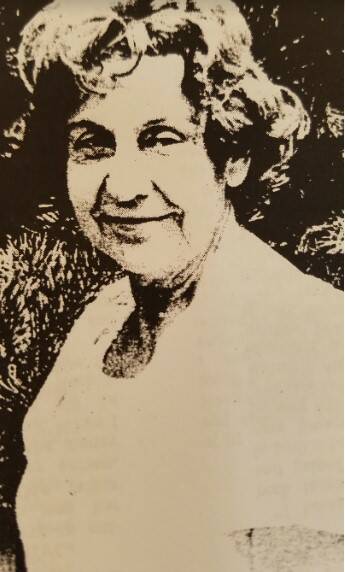The Fern Howe story was originally written by Dick Reed and published in the Sept. 18, 1974, issue of the Brown County Democrat.
Fern Howe has spent the last seven years working seven days a week at two regular jobs. In addition, she has found time to do physical labor on her 100-foot-long adobe-finished home of 4,000 square feet living space, including a 50-foot completely glassed in sunporch which she heats independently of the rest of the house.
Plans for the ranch-style home on 85 acres adjoining the T.C. Steele Memorial property evolved from those of a similar structure she admired near San Antonio, TX. The exterior, and part of the interior, are finished with five coats of adobe cement Fern herself applied, rubbing down each coat by hand. She also has finished all of the woodwork herself — in her spare time.
“I live in every square inch of this place,” she says, pointing out this and that special project underway but not completed in several rooms. “I can vacation in my own home.”
Fern retired from teaching last spring after 19 years at Nashville Elementary School. She taught first-graders for 13 years, also taught grades 2, 4 and 6. She is a registered nurse, too, and worked at that occupation on weekends and during school vacation periods while teaching at Nashville.
Until Sept. 1, she had spent Monday through Friday of every week, this summer, as an RN at Morgan County Memorial Hospital.
Her mother, Mrs. Clara Hinkle Keeler ha, is 92 years old and has been a resident of the Donna Nursing Home at Spencer since she was badly injured in a home accident during 1967.
Fern and Mrs. Keeler have been very close, especially since the husband and father, Edward Keeler, died while Fern was still in high school. Fern makes frequent trips to Spencer to check on Mrs. Keeler’s situation there.
For 36 years she has also tried to make one or two flying trips per year to the American Southwest, to visit Indian schools and hospitals and Indian friends in their homes on five reservations.
This has provided opportunities to buy turquoise jewelry products and expand her sources for turquoise and other Indian collectables.
She deals directly with the individual crafts people and has had to learn how to think, act and talk “Indian.”
Until now she has bought rings, bracelets, “squash” necklaces and the like only for herself and a circle of friends and acquaintances, but, she might decide to open a shop and conduct a retail business.
Right now, she keeps a collection of exquisite turquoise in several bank lock boxes. They’re to precious to be at home. In a shop she would continue to handle only those articles she tracks down herself in Indian country — no factory imitations and nothing the white man has made. Rugs, pottery and baskets could also be shop specialties.
Fern knows many artisans in those fields, too, but she says their numbers are dwindling. In one pueblo she visits, there are now only two elderly basket weavers. (The young Indian women go to the nearest towns and work in the factories.)
The wares Fern talks about are only the finest products from the most expert creators. And they’re hard to come by.
Last summer, for instance, she spent five hours persuading an old Indian woman on the Jamez reservation in New Mexico to sell her (for $75) a single 2-foot diameter, fringed yucca cactus leaf basket.
To get such a rare piece, Fern says, was well worth the time money and effort. She will continue to shop, or not shop, to visit and trade with friends she has made through the years among artisans of the Papago, Navajo, Hopi, Zuni and other tribes.
How much do the turquoise necklaces and bracelets sell for? Up to $2,500 each, if made by nationally recognized Indian artists. (Now you know why they are kept in safe deposit boxes in the banks!) If a squash blossom necklace is fashioned in gold, its value could zoom to ten or twelve thousand dollars.
To be continued.
Submitted by Pauline Hoover, Brown County Historical Society





